The Wonder Woman TV show—which ran on ABC from 1975-1977 and on CBS from 1977-1979—is remembered quite fondly by many, even those who didn’t actually like it much. The cheesy theme music, the spinning around to change identities, the different suits for different needs (a swimming suit, a motorcycle-riding suit, a skateboarding suit), the snotty IRAC computer, Lyle Waggoner’s perfectly unmoving hair—it’s all grist for the fond nostalgia mill.
Most of all, though—and this is the main reason why the show is remembered with a certain fondness even by those who disdain it—there was the absolutely picture-perfect casting of Lynda Carter in the title role, who ended almost every episode with a bright smile.
This was the third attempt to do Princess Diana of the Amazons on the small screen. William Dozier, trying to ride the wave of the 1966 Batman’s popularity, filmed a promo piece for his appallingly sexist, comedic take on Wonder Woman, which thankfully never saw the light of day. In 1974, Cathy Lee Crosby starred in an attempt by John D.F. Black to do Wonder Woman in a TV movie that was directed by Vincent McEveety (Black and McEveety were both vets of the original Star Trek). That movie bore only a passing resemblance to the comic book character and failed as a pilot.
The next person to take a shot at it was one of Dozier’s Bat-writers, Stanley Ralph Ross, who penned a 90-minute pilot called “The New Original Wonder Woman” to make it stand out from the Crosby movie (and make it clear that this version was way closer to the comics character). That pilot aired on ABC in November 1975, with more episodes airing sporadically through 1976 and early 1977, all taking place during World War II. The character was created by William Moulton Marston for National Periodical Publications (these days known as DC Comics) at the dawn of the second world war, with her earliest adventures tying into the war effort, and Ross followed that blueprint.
In 1977, ABC dropped it, and CBS picked it up, moving the series to a contemporary setting. Lyle Waggoner returned playing Steve Trevor Jr., the son of the war hero, now working for the Inter-Agency Defense Command, a fictional intelligence agency whose mandate was to be whatever that week’s plot needed it to be.
Upon rewatching the DVDs, I was struck by something astonishing: This show held a fantastic role model for little girls, and a reminder that they could be the equal of any man (still a radical notion in the late 1970s, and, indeed, today).
However, I’m not referring to Wonder Woman. I’m referring to Diana Prince.
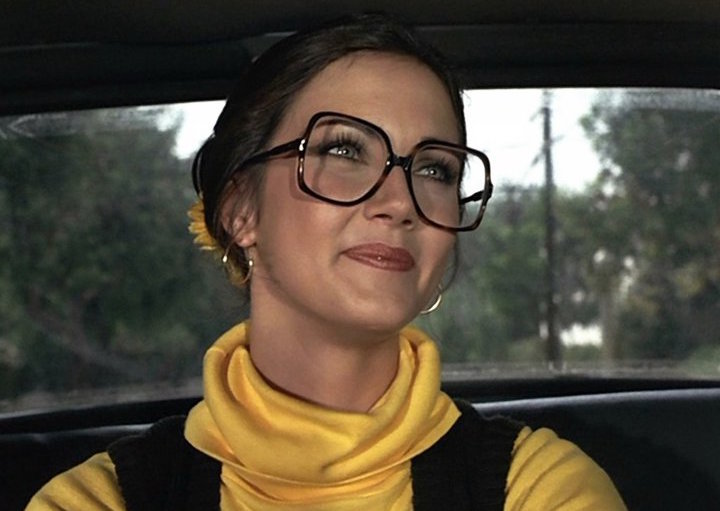
I can hear the confused snickers already. How is Diana Prince a role model? She was just Steve Trevor’s assistant who stayed behind at the office, and Wonder Woman got to do all the cool things. And during the World War II episodes, and even the first few episodes on CBS, this was true.
While on ABC, Major Steve Trevor was an Army Air Corps pilot (the Air Force didn’t exist until after World War II), who crash-landed on the uncharted “Paradise Island” in the Bermuda Triangle (or “Devil’s Triangle,” as it was often called) that was home to a group of Amazon warriors, immortal women who lived in isolation from “man’s world.” The Queen of the Amazons, Hippolyta, had a daughter named Diana, who accompanied Steve back to the United States to help fight the Nazis, who would overrun Paradise Island if they won the war.
Steve, despite being a decorated pilot, worked Army Intelligence in Washington, only actually flying a plane once or twice. Diana Prince was his aide (given the rank of yeoman), and used that position to learn of Nazi activity that she could combat as Wonder Woman. Part of the fun of those episodes was the gender reversal, as Steve was cast in the damsel-in-distress role, while Wonder Woman was the hero who rescued him. (Oddly, for a show about World War II, almost no time was spent on the front lines. The usual foes were fifth-columnists working to undermine the war efforts stateside. Wonder Woman did travel to Germany a couple of times, though.)
When the show moved to CBS and to a 1977 setting, very little changed at first. “The Return of Wonder Woman” started things off in much the same way that “The New Original Wonder Woman” did, going so far as to re-create the “bullets and bracelets” competition to determine who would venture out into the world. This time, it was Steve Trevor Jr., IADC agent, who wound up on Paradise Island and whom Wonder Woman accompanied back to “man’s world.”
The producers seemed unable to get out of the mindset of what they did at ABC at first. The cast structure was identical: Diana Prince was the aide to Steve Trevor, and they both reported to a senior official—the U.S. Army’s General Blankenship was replaced by IADC honcho Joe Atkinson. Steve went out into the field and carried out IADC missions, given to him, Joe, and Diana by an unseen official. (It was implied to be the President, and the briefings were given behind the White House seal, but (a) he was never referred to as the President, only as “sir,” and (b) the President doesn’t give assignments to field officers of any agency. But we’ll leave that aside, since the show itself abandoned that notion very quickly.) The first two episodes after CBS’s second pilot had World War II callbacks as well: “Anschluss ’77” had neo-Nazis creating a clone of Adolf Hitler, and “The Man Who Could Move the World” featured a Japanese-American whom Wonder Woman encountered as a boy during the war. The opening credits used the same animated comic-book-art theme as was used on ABC, with slightly updated lyrics to the theme song.
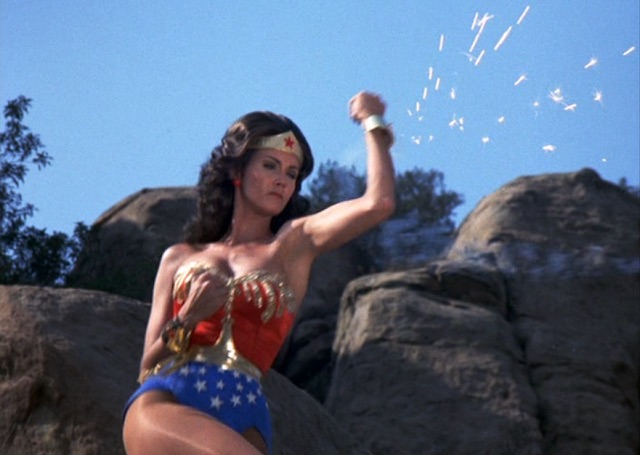
However, by the ninth episode, a sea-change had occurred. It had already started with Diana actually going into the field alongside Steve (“The Bermuda Triangle Crisis,” “The Queen and the Thief”), and even working on her own in “Knockout” (Steve was kidnapped during most of the episode), “The Pied Piper” (which involved Joe Atkinson’s daughter, and so Joe went into the field with Diana instead of Steve), and “I Do, I Do” (where Diana pretended to be married to a White House official as part of an undercover mission).
Then in the aforementioned ninth episode, “The Man Who Made Volcanoes,” it all changed. Steve was promoted to a supervisory position, with Joe written out. Suddenly, rather than being Steve’s aide, Diana Prince was routinely identified as one of the IADC’s top agents. When speaking to Professor Chapman (Roddy McDowall, the episode’s titular character), she mentions that she hadn’t seen him in two years—a neat trick, considering that the persona of Diana Prince hadn’t existed until a few months before. Later, in “Screaming Javelin,” Mariposa (Henry Gibson) alludes to past encounters with Agent Prince, whom he considers his nemesis. Diana was no longer a sidekick, but a full-blown important character in her own right.
The opening credits also reflected this new theme. Rather than an animated comic book for the whole thing, the credits became a montage of clips of Wonder Woman and Diana Prince both in action (plus a few shots of Steve for Lyle Waggoner’s credit), and the theme song was streamlined and modernized, with fewer lyrics. (This streamlining went further in CBS’s second and final season, with a disco beat added to the theme and all the lyrics gone save occasional recitation of the character’s name. Interestingly, those credits had fewer shots of Diana.)
Diana herself changed, too. In “The Return of Wonder Woman,” she wore a large pair of glasses, much like she did during World War II, and using the gold coins her mother gave her, she purchased a wardrobe that was almost entirely dowdy, meant to contrast with her sexy alter ego. This was also abandoned by the time “The Man Who Made Volcanoes” rolled around. Diana started wearing clothes that were at the height of fashion. That went into overdrive in the final season, where she was dressed like she was going to a fashion show, wearing more suit jackets and hats and skirts. The big glasses also took a supporting role, generally only worn when Diana was driving or working in the IADC office, and not even always then. She also wore her hair in a ponytail as Diana Prince, rather than up in a bun as she had in the early episodes. In later episodes, she occasionally wore it down as Diana. (How nobody figured out that this woman who looked and sounded just like Diana Prince, always turned up when Diana was in trouble, and was never in the same place at the same time as Diana is left as an exercise for the viewer.)
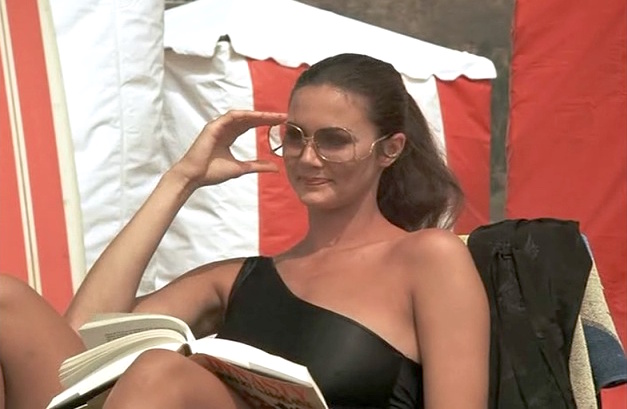
Finally, the entire notion of Paradise Island was all but abandoned. Aside from some vague references in “The Girl from Ilandia,” Wonder Woman’s home was never even referenced after “The Bermuda Triangle Crisis.” During the World War II episodes, Wonder Woman was the one with the life: she had a mother (played by Cloris Leachman initially, replaced by Carolyn Jones after the pilot, and then played by Beatrice Straight after the move to CBS), not to mention a sister (Debra Winger’s Wonder Girl, who appeared in “The Feminum Mystique” Parts 1-2 and “Wonder Woman in Hollywood”), and a support system back on Paradise Island, which was seen more than once. Diana Prince was just an identity she used to find out what Wonder Woman needed to do.
But in the 1970s, it’s Diana who has the life. We see her interacting with colleagues, and being friends with people (Joe’s daughter in “The Pied Piper,” a former coworker and her daughter in “Skateboard Wiz,” colleagues in “The Boy Who Knew Her Secret” Parts 1-2 and, again, “Skateboard Wiz”). After “The Man Who Made Volcanoes,” there are really only two characters who interact with Diana as Wonder Woman, rather than as Diana Prince: Andros, an alien, in “Mind Stealers from Outer Space” Parts 1-2 (and who is the son of the same-named character in the ABC episode “Judgment from Outer Space” Parts 1-2), and Emma-Donna, the titular character in “The Girl from Ilandia.” In both those cases, the characters are not from Earth, and knew about Wonder Woman as a member of the community of Paradise Island. But aside from that, references to her immortality and her background as an Amazon disappeared from the narrative.
At the time Wonder Woman was on the air, two of the most popular network shows were The Bionic Woman and Charlie’s Angels, both of which also involved women doing espionage work. Despite her super-powers, Jamie Sommers didn’t have an alter-ego as such, she just used her bionic powers in secret, and the Angels didn’t have any extranormal abilities at all. Wonder Woman followed their lead in many ways, limiting the appearances of Wonder Woman herself to when she was necessary to get Diana out of a jam. As the series went on, the title character’s appearances lessened even more—two notable episodes are “Amazon Hot Wax” and “The Man Who Could Not Die,” where Diana was unable to change to Wonder Woman in a spot where she normally would. Even on ABC, Wonder Woman generally didn’t stick around longer than was necessary, but that became almost pathological by the time CBS’s second season rolled around, with Wonder Woman getting only a small fraction of the screen time.

While Wonder Woman did have a lot in common with its contemporary women-doing-espionage shows, it differed in two very important respects, and that difference is another way that the show provided such a good role model for young women: The complete lack of any kind of love interest.
Hollywood has always tended to shy away from the completely independent woman, even now, and that tendency was greater in the late 1970s. Jamie Sommers was originally created solely as a love interest for Steve Austin in The Six Million Dollar Man, and only got her own series due to the character’s immense popularity and to actor Lindsay Wagner’s tremendous charisma. Even in her own series, though, she was very much the girl version of Steve Austin, and her relationship with him was always in the subtext. (Plus, of course, you had Richard Anderson’s Oscar Goldman practically drooling all over her every week.)
On the other end of the spectrum, we have Charlie’s Angels, where the three women weren’t really defined by their man, but were almost completely defined by their sexuality. They were drop-dead gorgeous and they used it to do what they had to do.
But neither Diana Prince nor Wonder Woman ever fell into either stereotype. For starters, she never used her beauty and sex appeal to get anywhere. Not that it was ever ignored—pretty much every male who crossed Diana’s and/or Wonder Woman’s path felt the need to tell her how gorgeous she was. But to her credit, she deflected the compliments (politely, always), and she never once used it to get something. Tellingly, while Diana’s clothes were always fashionable and elegant, they were very rarely revealing. Her own behavior was exactly the same as it would’ve been had she been a so-called “Plain Jane.”
(One could even point this up as an unrealistic behavior for a federal agent, who would likely use whatever weapons were at her disposal to get the job done, but the ways in which IADC agents behaved unrealistically are legion, and that is the least of them.)
Nor did she ever have a love interest on the show. Mind you, plenty of men applied for the position, from fellow government employees (“I Do, I Do”) to cops (“Hot Wheels”) to thieves (“Light-Fingered Lady”) to assorted geeks (“Diana’s Disappearing Act,” “The Fine Art of Crime,” “Spaced Out”) to aliens (“Mind Stealers from Outer Space” Parts 1-2) to football-players-turned-immortal-supermen (“The Man Who Could Not Die”).
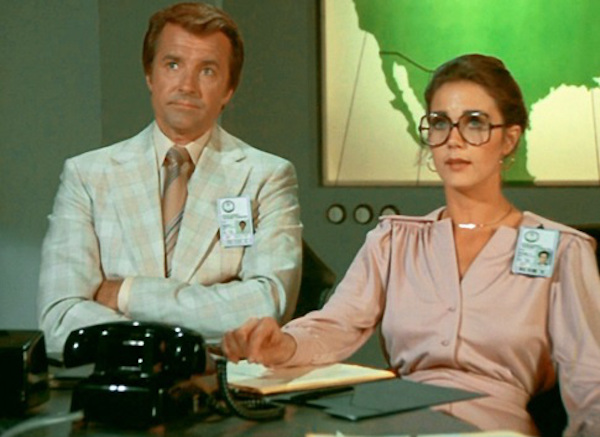
Oddly, the one person you’d expect to be a love interest was Steve Trevor, and that never happened. There were hints of flirtation and interest between Major Steve Trevor and Wonder Woman during the war, but Steve Jr. and Diana (and Wonder Woman) kept things completely professional and friendly. At the time the show was on the air, there were rumors that Waggoner and Carter didn’t get along, and that that was the reason for Waggoner’s curtailed screen time in CBS’s first season (fueled, no doubt, by the fact that most Diana-Steve interactions were over the phone, thus not requiring the actors to be in the room together). However, Waggoner was also elected mayor of Encino while the show was filming, and that seems a more likely reason for his reduced screen time (almost all of which was filmed in the IADC offices, and therefore could probably have been done in one day of shooting per week). Besides which, his screen time actually increased notably in the final season, as did his face-to-face interactions with Diana. (The animosity rumors were printed in TV Guide at the time, though Carter has denied them in recent times.)
Having said all that, CBS’s second season ended with a new status quo being set up for Diana. After contriving every possible excuse to send Diana to the field in Southern California, the producers finally decided to just have the show take place there. Diana was moved to the L.A. field office of the IADC in the episode “The Man Who Could Not Die.” That episode’s title character ends up working for the IADC, as both a love interest and as a possible crimefighting partner for Wonder Woman/Diana (an experiment made him immortal and invulnerable), and the show also added a new IADC supervisor, a hip little kid, and a chimp, with Steve Trevor apparently being written out. Mercifully, the show was cancelled before this new direction could take off.
There is a counterargument to be made here: Diana, after all, owes most of her success as an IADC agent to the fact that she’s also Wonder Woman. The shift in the show’s center actually damages the character’s credibility a bit. After all, most of what she accomplishes is only possible because she’s also Wonder Woman, and her superiors aren’t aware of it. Even though they aren’t, it’s also obvious that Wonder Woman is helping Diana. And it’s only Diana she’s helping. We never see her coming to the aid of any other IADC agents. (Of course, non-Diana IADC agents are like non-Jack Bauer CTU agents on 24: extras whose main purpose is to stand around and look stupid so our hero can do all the cool stuff.) One wonders if she would’ve been able to attain the status of “the IADC’s top agent” if she didn’t have a super-powered guardian angel.
There’s also the magic lasso, the truth-forcing abilities of which enabled her to gain intelligence she could not possibly have gotten any other way. It’s also an ethically dodgy tool, especially since she could use it to erase people’s memories. She only used it to wipe short-term knowledge (except on a couple of occasions where she wiped people’s memories with their express permission, such as “The Man Who Wouldn’t Tell” and “Formicida”), but it’s still a power that’s open to appalling abuse. However, she never did abuse it—never even came close. And the implication made in both “The New Original Wonder Woman” and “The Return of Wonder Woman” is that the lasso is a gift that she only earned by being worthy of it.
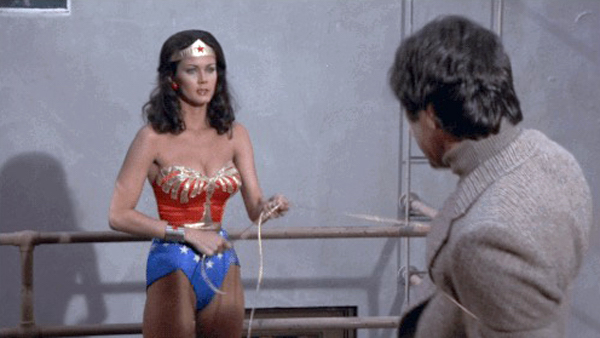
(At least the show’s producers acknowledged on a couple of occasions that testimony given under lasso, so to speak, wasn’t admissible in court, and the IADC never tried to use it that way. Wonder Woman/Diana simply used it for her own intelligence-gathering purpose.)
To its credit, the show made a few attempts to show Diana using skills that didn’t require Wonder Woman’s powers. Her undercover missions in “I Do, I Do,” “The Light-Fingered Lady,” and “Amazon Hot Wax” all required her to employ non-super-heroic talent in order for the cover to work. (Though the fact that the hypnotic massage used in “I Do, I Do” didn’t work on her was solely due to her Amazon heritage.) And every once in a while there were references to her attending high-level meetings and doing paperwork. In the final season, she was even able to take on people hand-to-hand when the opportunity to find a secluded spot to change into Wonder Woman didn’t present itself.
But still, in Diana Prince we had a woman who worked in two worlds that have traditionally been the bailiwick of men: superheroes and intelligence agents. In both of them, she excelled, and she never had to demean herself to do it, but did so on the strength of her own abilities. That those abilities were greater than most others doesn’t negate her accomplishments. Other people on the show have extranormal capabilities—Takeo Ishida (Yuki Shimoda) in “The Man Who Could Move the World,” Hamlin Rule (Martin Mull) in “The Pied Piper,” David Allen (Henry Darrow) in “I Do, I Do,” Hoffman (Frank Gorshin) in “The Deadly Toys,” Nick Moreno (Michael DeLano) in “Disco Devil,” Formicida (Lorene Yarnell) in “Formicida,” Bonnie (Jane Actman) in “The Girl with a Gift for Disaster,” etc.—but they all either abused that power, or were used by other people for nefarious purposes.
Wonder Woman a.k.a. Diana Prince only used her power for good. She fought for our rights in satin tights, and you can’t ask for more than that.
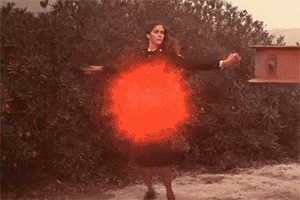
Several other attempts at a TV series featuring Wonder Woman have been made since Carter hung up her bustier, including a 1990 pilot announcement that never got off the ground, a 2011 pilot that was filmed but not picked up starring Adrianne Palicki, and a 2012 announcement that the CW would be doing a show called Amazon as part of its “Arrow-verse” shows. Allegedly, the latter is still a possibility in the future. There were thoughts of having a young Diana appear in Smallville, but that never happened, either. The next time we would truly see Wonder Woman in live action was Gal Gadot in Batman v. Superman: Dawn of Justice.
Keith R.A. DeCandido is really looking forward to the Gal Gadot Wonder Woman in June, and rewatched Lynda Carter’s series and the 2009 animated Wonder Woman in preparation. Look for his thoughts on the latter elsewhere on this site. He’s been writing about Star Trek, Stargate, Batman 66, Doctor Who, and Marvel’s Netflix series for Tor.com since 2011, and will soon embark on an overview of comic book superheroes adapted into live-action movies (the Cathy Lee Crosby 1974 Wonder Woman movie among them). He’s also an award-winning best-selling author of more than fifty novels, among the most recent of which is a novel trilogy called Marvel’s Tales of Asgard, starring another superhero with mythological roots, Thor (as well as Sif and the Warriors Three), on sale now from Joe Books.










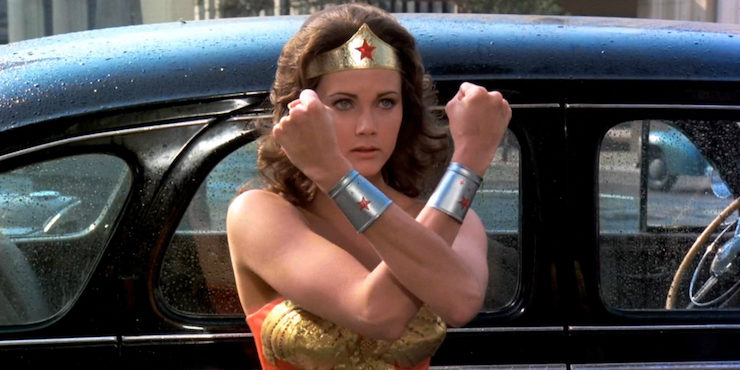
You offer an interestingly positive perspective of the CBS seasons of Wonder Woman. Kudos for the feminism and all, but they were pretty terrible overall. When I rewatched them last year, the only reason I could stand to sit through the whole thing was my deep appreciation of Lynda Carter’s looks, though not so much her acting ability. The IADC era was relentlessly dumb, cheesy, and formulaic, and Diana was changed from her original warm, compassionate persona to a more sarcastic, impatient personality that was far less appealing (though perhaps it could’ve worked in the hands of a more talented character actress). I liked the WWII season much better — it was surprisingly true to the comics for a ’70s show.
Although the IADC era would’ve fit pretty well with the “powerless Wonder Woman” era of the comics from a few years earlier, when Diana lost her powers and ditched her costume and became a fashion-plate secret agent in the Emma Peel mold. Given that the show seemed to be trying to minimize Wonder Woman’s screen time as much as possible, I suspect Bruce Lansbury and the other producers might’ve been happy to ditch the satin tights altogether and just have Diana be a regular secret agent full-time. The show might even have made more sense that way, without the constant absurdity of nobody recognizing that Diana and WW were identical in face, voice, figure, itinerary, and goals.
“(Oddly, for a show about World War II, almost no time was spent on the front lines. The usual foes were fifth-columnists working to undermine the war efforts stateside. Wonder Woman did travel to Germany a couple of times, though.)”
That wasn’t odd at all for ’40s superheroes at the time. Modern depictions tend to show them actively fighting in Europe, but while the war was going on, it was more common to show superheroes and other action heroes defending the home front from saboteurs and fifth columnists, supplementing the work of the troops abroad — partly to explain why the superheroes didn’t just end the war with their powers, and partly so as not to devalue the efforts of the “real heroes” on the front by suggesting that a fictional character could do their job better. In addition to the actual comics, you could see or hear this in contemporary adaptations. In the first incarnation of the Superman radio series, Clark Kent was appointed as an operative of a government intelligence agency protecting the home front, though he did get some adventures abroad in the slightly rebooted series that came along later in the war. And the very racist 1943 Batman movie serial made Batman and Robin government agents fighting Japanese saboteurs in Gotham City.
So on the Joe Johnston scale, WWII-era superhero stories were generally more The Rocketeer than Captain America: The First Avenger.
“(Plus, of course, you had Richard Anderson’s Oscar Madison practically drooling all over her every week.)”
Oscar Goldman. Oscar Madison was Felix Unger’s roommate in The Odd Couple.
Oscar Goldman, surely. Oscar Madison was in The Odd Couple.
Edit: Ninjaed by a matter of seconds by ChristopherLBennett.
GAH! I must’ve proofed this thing, like, a dozen times, and I missed “Oscar Madison” every damn time. Sheesh. It’s fixed, thank you, Christopher and NomadUK.
—Keith R.A. DeCandido
Great article, krad, I never knew much about this show, but it seems like it’s a pretty good portrayal of Marston’s feminist ideals (however wild some of them were). Thank you. Wait… “hypnotic massage”? That sounds fun.
My daughters are watching this show via MeTV and they love it. As do I, for what it is in general teaching them. Wonder Woman is one of their heroes, and for that I am grateful.
— Michael A. Burstein
I loved this show as a kid.
A friend of mine was immensely influenced & encourage by Lynda Carter’s Wonder Woman. And as she has gone on to have a rather successful career as an artist and comic book illustrator, I know that show’s positive message definitely helped her.
I loved her for the simple fact that she did what Christopher Reeve would do as Superman, she made me believe that she was ‘real.’ No small feat for a show not directly aimed @@@@@ young boys – well, at least in the minds of the network.
Kato
The fascinating thing about the ’70s in retrospect is that it was a peak era for female-led superhero shows on American TV. There were four I know of that overlapped, with all four being on the air in 1976-7: Wonder Woman and The Bionic Woman in prime time and The Secrets of Isis and Electra Woman and Dyna Girl on Saturday mornings. While there was a certain degree of chauvinism to them by modern standards (for instance, Filmation producer Lou Scheimer was unapologetic about the fact that he’d cast Isis‘s Joanna Cameron mainly for her stunning legs), they all showed female heroes as strong, smart, independent, and capable — well, at least the three I remember did. (I recall little about EW&DG, aside from the fact that it was basically a spoof of Batman ’66, which was a spoof in itself.) But the trend burned out after a few years, and we didn’t have that much in the way of female-led superhero or action shows until the ’90s with Buffy and Xena, and again now with things like The Legend of Korra, Supergirl, and Jessica Jones. It seems to peak in 20-year cycles, but 1976 was an unusually high peak. It’s particularly impressive that ’70s TV execs were willing to put two female-led shows on Saturday morning; today, kidvid providers like Cartoon Network pander overwhelmingly to young male viewers and consider female-led shows to be nonstarters.
I loved this show as a kid in all it’s goofy cheesy glory. I never understood how it went from WWII to Modern times between seasons there was never any transition. I didn’t know it changed networks. Considering it was on when I was on I was between 4 and 8 I wouldn’t have paid attention to which channel it was on just the time. Besides back then we only had about six channels to choose from anyway. I also am a huge fan of the Bionic Woman. It’s one of my favorite 70’s tv shows. I enjoy the episodes I catch on cable every once and a while. To put a caper on my 70’s nostalgia the El Rey networked marathoned all the episodes of the Incredible Hulk tv show this weekend. It was awesome.
Please please please do a re-watch of this in the vein of the Batman’66 watch…
I also preferred the World War Two episodes. In the 80’s comics in the D.C. Universe the spear of destiny would allow hitler to control any “magical ” based heros explaining why superman, green lantern Wonder Woman could not just go over to europe and win the war!
Actually in 1 episode Diana Prince did use her sexuality to achieve something that she needed. In the WWII episode Formula 407 Diana is trying to fend off the unwanted advances of a party guest named Antonio. When she notices that Steve is in trouble Diana slowly removes her glasses and cozies up to Antonio to distract him and sends him off to get her a glass of champagne so that she can slip out onto the balcony and transform into Wonder Woman.
God help me, the show was the height of cheese, but it at least introduced 1980 Me to the terrible internment of Japanese-American citizens during WWII. I think I watched the entire episode going “But we were the good guys!”
It is worth watching the 1975 pilot for the TV series (originally a TV movie). It is a pretty solid origin story with better production values than the TV series. And they pulled in some pretty big names–Cloris Leachman had won an Oscar in 1971.
But the best part is the commentary by Lynda Carter and Douglas S. Cramer. Lynda is a hoot. In one scene, she is wearing the Golden Age skirt then removes it. Lynda says that once she took that skirt off, they never let her put it back on.
I haven’t seen the new one yet, but until this year, that pilot is the best Wonder Woman movie ever made.
http://www.imdb.com/title/tt0073449/?ref_=ttep_ep1
Also, I believe the spin change originated in the TV series, then moved to the comic books. From there, it has grown to take up at least 20% of the run time of Sailor Moon episodes.
@14/wunder: Here’s a blog article about the evolution of Wonder Woman’s costume change in the comics:
https://thanley.wordpress.com/2010/11/27/the-evolution-of-the-costume-change/
There actually were a couple of early comics, one way back in issue #6 and one in 1958, that showed Diana changing into Wonder Woman in such a quick blur of motion that it seemed like a spin. In 1974, the comics introduced the idea that she changed costumes by twirling her lasso around herself.
You can see in the video clips in the blog that in the pilot and early episodes of the TV series, the spin change didn’t include a flash of light; it was a slow dissolve from Diana in civvies to WW in costume and holding her civvies, which she then stowed somewhere out of sight. I guess the implication was that, as in the early comics, she was just changing so fast that it became a blur. But they soon started doing the flash of light instead — I guess because then they could just do a jump cut from one costume to the other and hide it behind the flash, so it was probably cheaper and easier to do. Also because having her clothes magically disappear meant they no longer had to worry about where she’d hide them. And once season 2 came along, the magic costume change let them expand to other costume variants like the wetsuit and motorcycle suit. Initially she had to change to the standard costume first and then a variant, but later on she could change straight to a variant costume. (I got to wondering — does she prepare these outfits in advance and store them in some magical hammerspace to be called up as needed? Or does she improvise them on the spot and use the magic spell to create them by pure willpower?)
By the way, I only had a black and white TV when this show was in first run, so it wasn’t until my recent rewatch on MeTV that I realized the flash of light in the costume change cycles from red to white to blue.
Loved it, for most of the reasons you give.
But you under rate Charlie’s Angels. Love interests were transient (much like female love interests in male oriented shows) and that was empowering. They left for new jobs not for marriage. And Kate Jackson was just awesome: it wasn’t necessarily little *boys* with a crush on her (grin).
One small correction, military terminology dept. “Yeoman” is not a rank, it is a rating, an enlisted person’s occupational description, equivalent to the Army’s MOS system. In the USN one’s enlisted rank is their rate, and their job is their rating. Yeoman, in modern parlance, designates an office or secretarial worker. And since military intelligence often draws resources and personnel from across multiple branches, its not that odd for Diana and Steve (Mk 1) to have worked together.
rocketjay: Ah, okay, my mistake. Thanks!
—Keith R.A. DeCandido
As a kid growing up in the 70s and 80s, I lived in Burbank, CA and many TV series and movies filmed right around our house. We lived in an odd little neighborhood; within a three block area, we had houses, apartments, small town commercial, a bar, and a couple of small industrial/warehouse type buildings with a couple of major streets, several alleys, four residential streets and a parking lot. So you could film an entire chase scene or do several scenes in different environments without having to move the whole crew and equipment to a different location. Our house was on the corner right in the middle of it all. We were fortunate enough to meet a lot of actors and film crew people through the years. Our family from out of state loved to visit us and see an actual film crew at work right outside our house. Sometimes, we even got to be in the background and once I got to run right into a chase scene. All these years later, I still have my autograph books filled with the signatures of familiar actors from the 70s and 80s. I have to say that just about everyone from actors to crew were kind and patient with us kids. My childhood home is gone now, but any time I want to see it, I can just turn on MeTV and it’ll show up on a show sometime during the day. My mom had a little crush on Lyle Waggoner and made him an apple pie. I got his and Linda Carter’s autographs because she sent my little sister and me across the street to deliver it while she watched out the kitchen window. I remember Linda Carter as being so beautiful and she was lovely to us, answering all our questions very patiently. I got to touch the golden lasso. It’s a great memory.
What a nice memory. Thank you for sharing, RobinC.
Keith: “the Air Force didn’t exist until after World War II…”
As one of the seven wholly independent uniformed serves we know today, no it didn’t, but it WAS a part of the Army, and I believe it was called the United States Army Air Force.
Luigi: um, the words right before the parenthetical phrase you quoted acknowledged that: it was the United States Army Air Corps. The Air Force was split off into its own thing in 1947.
—Keith R.A. DeCandido